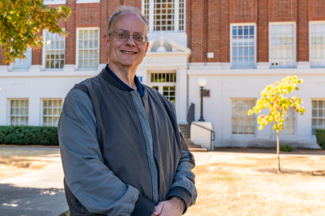He is the man to know at NETL’s research campus in Albany, Oregon.
As lead facilities and project engineer at NETL-Albany, Lee Jensen keeps his finger on the pulse of small and large construction activities and other improvements planned at the U.S. Department of Energy research site.
“He is the main point of contact for everything Albany,” said Larry Kincell, Jensen’s supervisor. “He’s very much on top of everything happening.”
Multiple construction projects are scheduled in the near term at the 42-acre campus. Jensen will play a major role in advancing many of them, including high-profile projects to expand NETL-Albany’s expertise in the development of high-performance alloys and to increase its use of clean energy.
A mechanical engineer who earned his bachelor’s and master’s degrees at Utah State University and the University of Utah, respectively, Jensen wears many hats in the performance of his duties. He relies on his extensive background and experience to develop project schedules, review designs and even serve as NETL-Albany’s unofficial historic preservationist.
“The variety of the work makes life very interesting for me because I am always learning about new things,” said Jensen, who has worked at NETL-Albany since 2004.
Construction of the Advanced Alloys Signature Center (AASC) at NETL-Albany is planned to begin in early 2024. NETL-Albany is internationally recognized for its leadership in developing advanced materials and alloys for use in energy applications and extreme service environments. The AASC will accelerate the development of innovative alloys for commercialization and ensure the United Sates maintains its leadership in the specialty alloy sector.
“It’s an important project because it creates a state-of-the-art metals fabrication facility that will contain three test laboratories to develop alloys with optimum performance characteristics,” Jensen said.
High-performance alloys are needed for many industrial applications and to reduce emissions generated by power plants. “Advanced alloys are essential to build components that can withstand higher temperatures and pressures so that intermittent renewable energy sources such as wind and solar power can be used with greater frequency to produce electricity,” Jensen said.
Jensen’s list of other major projects for 2024 includes construction of a 1-megawatt solar array in the southern portion of the NETL-Albany site.
Currently, up to 97% of the power for NETL-Albany comes from the Bonneville Power Administration, which delivers reliable, inexpensive and carbon-free hydropower produced in the Columbia River Basin to communities across the Northwest.
“When the on-site solar project is completed, all energy for the Albany site will be from renewable sources,” Jensen said.
He is involved in other major projects that have yet to proceed to the design stage. These projects include the development of the Geoscience, Environmental and Materials (GEMS) Computational facility. Funded by the Inflation Reduction Act, GEMS will support advanced computing competencies applied to materials, computational fluid dynamic modeling and geoscience research.
In addition, Jensen anticipates leading the space management team in Albany in developing a hybrid workplace environment that enables employees to enhance meaningful in-person collaboration to improve efficiency and retention.
Other projects are linked to NETL-Albany’s historic past.
The NETL-Albany site traces its origins to 1943 when President Franklin D. Roosevelt announced that a new electro-metallurgical laboratory would be established in Albany. Prior to becoming a research site, the property that houses NETL-Albany served as the campus of the Albany Collegiate Institute.
In the intervening 80 years since FDR’s announcement, the Albany site has become one of the nation’s premier materials research laboratories, helping birth both the zirconium and titanium industries. In 1984, ASM International, the world’s largest and most established materials information society, recognized the laboratory for pioneering the process of making ductile zirconium and designated the site an ASM Historic Landmark.
Jensen noted that one of the oldest buildings on-site was once used as a college dormitory. However, it is no longer structurally safe and is scheduled for demolition.
Before demolition occurs, Jensen is working with Oregon’s State Historic Preservation Office to document the historic significance of the building and identify items to salvage and preserve.
“So far, that list includes fireplaces, hearths and mantles that could be donated to a local history organization so that chapter of our site is not forgotten,” Jensen said.
Phillip Lemonds, site manager at NETL-Albany, said Jensen understands the importance of collaboration and coordination to achieve positive results.
“Lee was the project manager for the widening of the NETL-Albany main entrance. He worked closely with the City of Albany months in advance to schedule the main entrance work to coincide with the city’s road work on Queen Avenue,” Lemonds said.
Thanks to these efforts, both the main entrance and the Queen Avenue paving was completed before the school year began. “Lee did an exceptional job communicating all outages and finishing the project ahead of schedule,” Lemonds said.
In his free time, Jensen enjoys fishing, hiking, camping and traveling with his wife, Debbie, and their sons, Daniel and Jacob.
NETL is a U.S. Department of Energy national laboratory that drives innovation and delivers technological solutions for an environmentally sustainable and prosperous energy future. By leveraging its world-class talent and research facilities, NETL is ensuring affordable, abundant and reliable energy that drives a robust economy and national security, while developing technologies to manage carbon across the full life cycle, enabling environmental sustainability for all Americans.




